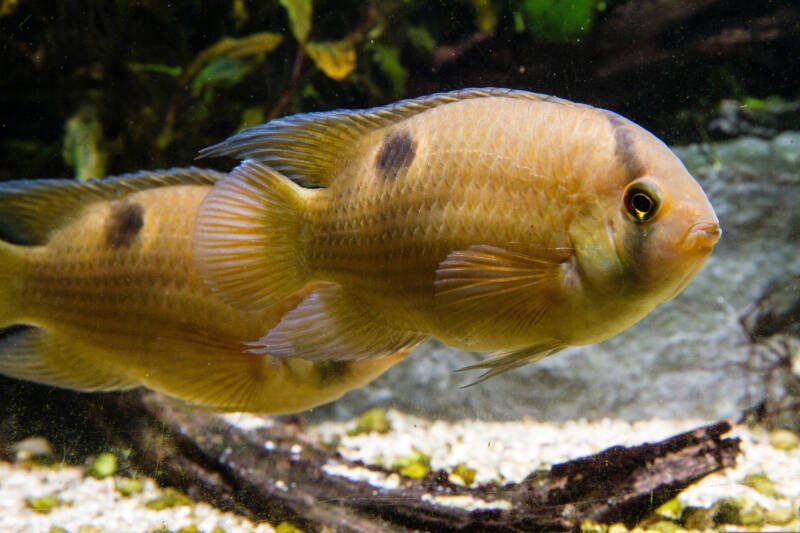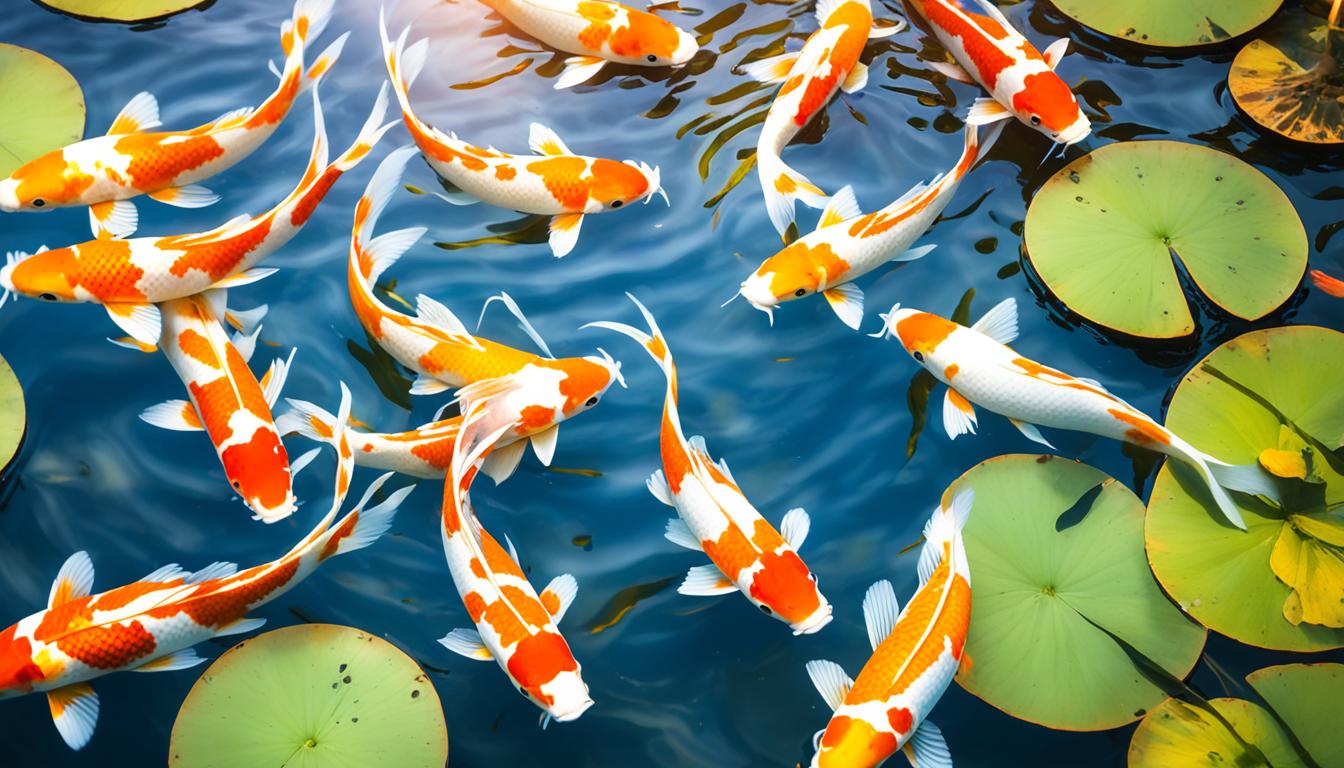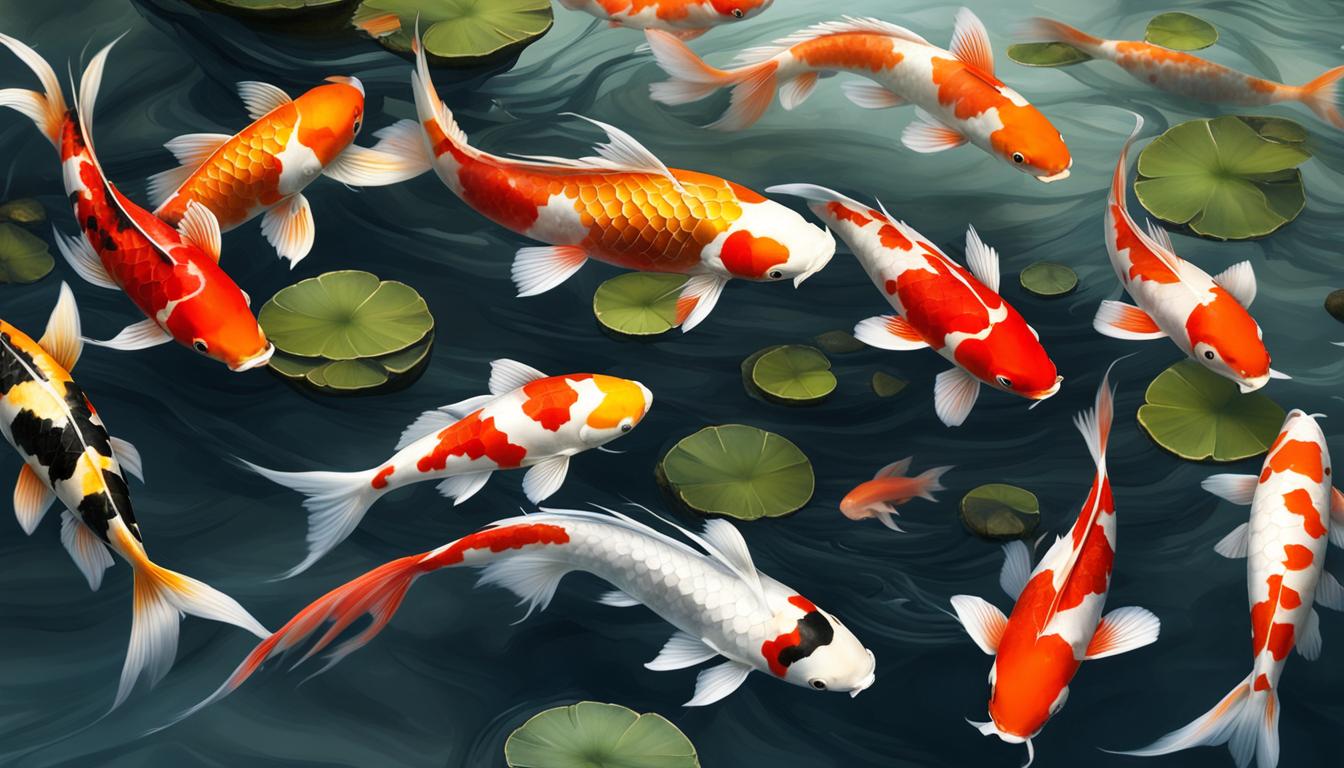The keyhole cichlid is a peaceful and shy cichlid fish native to tropical South America, specifically the lower Orinoco Basin in Venezuela and river basins in The Guianas. It is a popular choice for aquarium enthusiasts due to its unique keyhole marking and gentle temperament.
Keyhole cichlids can grow up to five inches in the wild, with juveniles ranging from one to three inches in length. However, in aquariums, they typically only reach a maximum size of four inches. These omnivorous fish have a slow growth rate, with a one-inch juvenile taking over six months to double in size.
They thrive in setups with plenty of live plants and can be fed high-quality pellets, flakes, and live or frozen foods like brine shrimp and daphnia.
Table of Contents
Size And Growth
The Keyhole Cichlid, a popular fish among hobbyists, can grow up to five inches in the wild, but usually reaches four inches in a tank. They have a slow growth rate, taking over half a year for a one-inch juvenile to become two inches in size.
Keyhole Cichlid size in the wild and in aquariums:
In the wild:
- Keyhole cichlids can grow up to five inches in length.
- They are usually smaller in size compared to their aquarium counterparts.
- Adult keyhole cichlids in their natural habitat typically reach sizes between three to five inches.
- However, some individuals may grow even larger under favorable conditions.
In aquariums:
- Keyhole cichlids tend to be smaller in size when kept in aquariums.
- They typically reach sizes between two to four inches.
- Factors such as tank size, diet, and water quality can influence the growth of keyhole cichlids in captivity.
- Although they may not reach their maximum potential size, they can still exhibit their distinctive keyhole shape and behavior.
Growth rate of Keyhole Cichlids and factors that influence it:
- Keyhole cichlids have a slow growth rate compared to other fish species.
- Juveniles, measuring one to three inches, may take over half a year to reach two inches in size.
- The growth rate can vary depending on several factors, including:
- Water temperature: Warmer water temperatures generally promote faster growth in keyhole cichlids.
- Diet: Providing a nutritious diet with a variety of foods enhances their growth.
- Tank size: Offering a spacious environment allows keyhole cichlids to grow more comfortably.
- Water quality: Maintaining clean and well-filtered water helps support healthy growth.
- Genetics: Individual genetic variations can also affect the growth rate of keyhole cichlids.
By understanding the size and growth of keyhole cichlids, you can create an environment that supports their well-being and helps them thrive in your aquarium. Remember to monitor their growth and provide appropriate care to ensure their optimal development.
Tank Requirements
The keyhole cichlid, endemic to tropical South America, is a popular choice for aquariums. With a slow growth rate, they typically reach four inches in tanks and have an omnivorous diet that includes high-quality pellets, flakes, and live/frozen foods. Ensure plenty of live plants for their tank setup.
N size. They typically reach their full size within one to two years.
Minimum Tank Size For Keyhole Cichlids:
- A minimum tank size of 30 gallons is recommended for a pair of Keyhole Cichlids.
- A larger tank of 50 gallons or more is ideal for a community of Keyhole Cichlids.
- Keyhole Cichlids appreciate ample swimming space, so a longer tank is preferable over a tall one.
- Providing enough space will help reduce territorial disputes and promote a peaceful environment for the fish.
Suitable Tank Mates For Keyhole Cichlids:
- Keyhole Cichlids are generally peaceful and can coexist with a variety of tank mates.
- Peaceful community fish such as tetras, rasboras, and dwarf gouramis make excellent companions.
- Avoid keeping Keyhole Cichlids with aggressive or territorial fish that may stress or harm them.
- Bottom-dwelling species like catfish and Corydoras can also be good tank mates, as they inhabit different areas of the tank.
- Placing Keyhole Cichlids with similarly sized and temperamented fish will ensure a harmonious tank environment.
Ideal Hiding Spots And Decorations For Their Habitat:
- Providing ample hiding spots is crucial for Keyhole Cichlids to feel secure and reduce stress.
- Use driftwood, caves, and rock formations to create hiding places and territories for the fish.
- Live plants, such as Amazon swords or Java ferns, not only enhance the aesthetics but also provide cover and oxygenation.
- Create a natural-looking environment with an evenly distributed mix of open spaces and hiding spots.
- Utilize fine-grained sand or small-sized substrate to mimic their natural environment and accommodate their digging behavior.
Remember, creating a suitable tank environment for your Keyhole Cichlids is vital to their well-being and overall happiness. By following these guidelines, you can provide a comfortable and visually pleasing habitat for these beautiful fish.
Care And Maintenance
The Keyhole Cichlid, a popular fish species among hobbyists, is an endemic cichlid fish found in tropical South America. Known for its shy and peaceful nature, this omnivorous fish thrives on high-quality pellets, flakes, and live/frozen foods, and prefers a tank setup with plenty of live plants.
It generally grows up to four inches in captivity, with a slow growth rate.
The Keyhole Cichlid is a popular choice among fishkeeping enthusiasts due to its peaceful temperament and attractive appearance. To ensure the well-being of your Keyhole Cichlids, it is essential to provide proper care and maintenance. Here are some key aspects to consider:
Temperature Requirements For Keyhole Cichlids:
- Keyhole Cichlids thrive in water temperatures between 74-82°F (23-28°C).
- It is crucial to maintain a stable temperature range within the aquarium to promote their overall health and well-being.
Diet And Feeding Habits Of Keyhole Cichlids:
- Keyhole Cichlids are omnivorous and have a varied diet.
- Offer a combination of high-quality flakes or pellets as their staple diet.
- Supplement their diet with live or frozen foods such as brine shrimp, bloodworms, and daphnia to provide essential nutrients.
Water Quality Parameters And Maintenance Tips:
- Maintain proper water quality by performing regular water changes of 25% to 30% every two weeks.
- The ideal pH range for Keyhole Cichlids is between 6.5-7.5.
- Ensure the water hardness level remains moderate, around 4-8 dKH.
- Maintain good filtration and proper oxygenation within the aquarium.
- Provide plenty of hiding places, such as caves or driftwood, to create a secure and comfortable environment for them.
Remember, consistent care and maintenance are vital for the overall health and well-being of your Keyhole Cichlids. By adhering to these guidelines, you can create an optimal living environment for these beautiful fish and enjoy their unique characteristics in your aquarium.
Behavior And Characteristics
The Keyhole Cichlid is a shy and peaceful cichlid fish native to tropical South America. It is popular among fishkeeping hobbyists and can be found in aquariums. This species is known for its omnivorous diet and should be provided with high-quality pellets, flakes, and live/frozen foods.
In terms of tank setup, plenty of live plants are recommended.
Description Of The Peaceful Nature Of Keyhole Cichlids
- Keyhole Cichlids are known for their gentle and peaceful nature, making them an excellent addition to community aquariums.
- These fish are non-aggressive and rarely show any territorial behavior, making them compatible with a variety of other fish species.
- Keyhole Cichlids prefer a calm and peaceful environment, so it’s important to provide plenty of hiding places and vegetation in the tank.
- Despite their non-aggressive nature, Keyhole Cichlids can become slightly territorial during breeding season, especially around their chosen spawning site.
- Overall, their peaceful behavior and compatibility with other fish make them a popular choice for aquarists looking for a serene and harmonious aquarium.
Observations On Their Coloration And Distinct Markings
- Keyhole Cichlids have a unique and attractive appearance, with distinct markings that set them apart from other fish.
- They have a round and flattened body shape, with a distinctive black spot located on their sides. This black spot resembles a keyhole, giving them their common name.
- The rest of their body is usually a pale yellow or tan color, enhancing the contrast of the black spot.
- Additionally, Keyhole Cichlids may display iridescent blue markings on their fins, adding to their visual appeal.
- The combination of the black spot, pale body, and iridescent markings make Keyhole Cichlids visually stunning and a delightful addition to any aquarium.
Omnivorous Diet And Its Effects On Overall Behavior And Health
- Keyhole Cichlids are omnivorous, which means they have a varied diet consisting of both plant matter and small invertebrates.
- In their natural habitat, Keyhole Cichlids feed on insects, insect larvae, worms, and plant matter found in the rivers and streams of South America.
- In captivity, they should be provided with a balanced diet that includes high-quality pellets or flakes, as well as occasional live or frozen foods such as brine shrimp or bloodworms.
- Their omnivorous diet plays a crucial role in their overall behavior and health. A well-fed Keyhole Cichlid tends to be more active, vibrant, and engaging in their surroundings.
- It is important to avoid overfeeding Keyhole Cichlids, as excessive food consumption can lead to obesity, which can negatively impact their overall health and lifespan.
Keyhole Cichlids are peaceful fish with a distinct appearance and unique markings. They thrive in aquariums with a calm and harmonious environment, where they can coexist peacefully with other fish species. Their omnivorous diet contributes to their overall behavior and health, making it essential to provide them with a balanced and varied diet.
By satisfying their dietary needs and ensuring a suitable habitat, aquarists can enjoy the beauty and serenity these fish bring to their aquariums.

Credit: fishtankadvisor.com
Frequently Asked Questions For Keyhole Cichlid
What Tankmates Do Keyhole Cichlids Get Along With?
Keyhole cichlids get along well with peaceful tankmates like tetras, rasboras, and peaceful catfish.
Can Keyhole Cichlids Be Kept Alone?
Keyhole cichlids can be kept alone as they are peaceful and shy in nature.
Are Keyhole Cichlids Peaceful?
Keyhole cichlids are peaceful fish that are popular among fishkeeping hobbyists for their gentle nature.
What Is The Lifespan Of A Keyhole Cichlid?
The lifespan of a keyhole cichlid typically ranges from 8 to 12 years.
Conclusion
Keyhole cichlids, also known as Cleithracara maronii, are fascinating fish native to tropical South America. These cichlids are popular among fishkeeping enthusiasts due to their unique keyhole-shaped markings and peaceful temperament. With a slow growth rate, these cichlids typically reach a length of four inches in aquariums, although they can grow up to five inches in the wild.
Keyhole cichlids are omnivores, and their diet should consist of high-quality pellets, flakes, and live or frozen foods like brine shrimp or bloodworms. When it comes to their tank setup, keyhole cichlids prefer plenty of live plants to provide hiding places and offer a sense of security.
Originating from the lower Orinoco Basin in Venezuela and river basins in The Guianas, these beautiful fish add a touch of tranquility to any aquarium. So, if you’re looking to create a peaceful and visually appealing aquatic environment, consider adding keyhole cichlids to your tank.
I am a passionate aquarist with over 30 years of hands-on experience in fishkeeping. My journey began at a young age, collecting fish from the wild and learning through experimentation. Specializing in tropical fish, I bring a deep understanding of the hobby to FishKeepingMadeSimple. The site provides honest, detailed reviews of essential products and accessories to help fellow enthusiasts create the best environments for their fish.










[…] you want to add a touch of natural beauty to your aquarium without the hassle of intense lighting and CO2 supplementation, Java Moss is an excellent choice. […]